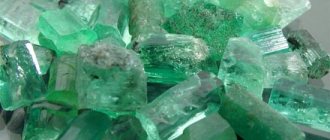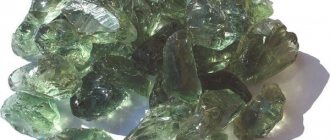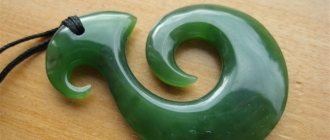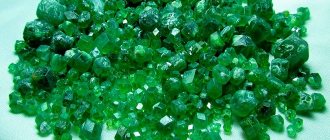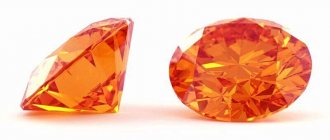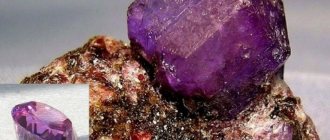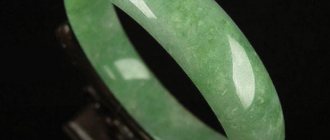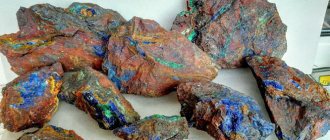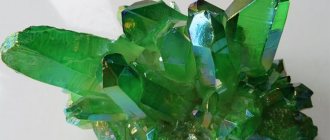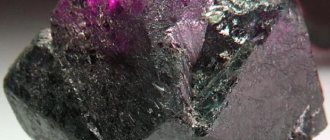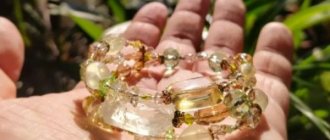Precious minerals
There are quite a lot of stones representing the whole gamut of green in nature. Among them are the well-known emerald and jade, as well as the less famous peridot, tsavorite and verdelite. For a number of minerals, green is the main color, while for others it is a rare and valuable variety.
MERCURY – EMERALDEmerald, the main gemstone of Mercury, maintains a balanced ratio of all three...
Published by Astrology, Ayurveda Wednesday, April 1, 2015
Emerald
The most famous gemstone is green. By its nature, it is a type of beryl group. The rich color of fresh greens ensures a high content of chromium impurities in the mineral.
Emerald is a durable stone that can be cut in almost any way. High quality minerals are transparent and uniform in color. Most of them are mined in Brazil, Egypt, and Zambia. This gem is also mined in Colombia, the USA, Russia, India, South Africa, India, Pakistan and China.
Interesting! The largest emerald in the world, Theodora, weighs 11.5 kg (57,500 carats).
Alexandrite
A rare and amazing mineral, one of the five most expensive gems in the world. Its distinctive feature is its color reverse. When changing lighting from natural to artificial, the gem changes shade from green to red. Jewelry made from this stone is mainly made to order.
Alexandrite is of Russian origin, as it was first found in the mines of the Urals. Today this mineral is also mined in Sri Lanka, Brazil, Tanzania and Madagascar.
Sapphire
The green variety of sapphire is called chlorosapphire or oriental emerald. Alexander the Great wore a ring with this stone, considering it his talisman and amulet.
High-quality sapphires are cut into oval or circle shapes. A stepwise cutting method is often used, which increases the refractive index of light. Lower quality gemstones are cut into cabochons.
Deposits of green sapphires are located in Myanmar, India, Australia, Thailand, Madagascar and the USA.
Interesting! It is not impurities and inclusions that are responsible for the green tint of a crystal, but a structure consisting of alternating yellow and blue layers.
Diamond
One of the rarest minerals is green diamond. This fancy gemstone owes its color to inclusions of nitrogen and irradiation with uranium and thorium during its crystallization process.
In laboratories, they have learned to “color” transparent stones using irradiation, but such specimens are significantly inferior in price to the originals.
Deposits of valuable gems have been discovered in South Africa, Australia, India, Brazil and Russia (Siberia).
| Name | Origin | Characteristics | Price per 1 carat (in rubles) | ||
| Color | Substance that affects color | Hardness | |||
| Emerald | one type of beryl | yellow-green to blue-green | chromium impurities | 8 | from 90-100 thousand |
| Alexandrite | type of chrysoberyl | color reverse | chromium impurities | 8,5 | from 300 thousand |
| Sapphire | type of corundum | light to dark green | No | 9 | from 35 thousand |
| Diamond | type of graphite | yellow-green to dark | nitrogen impurities | 10 | from 1 million |
The best settings for precious gems are yellow gold and platinum. Jewelry with these stones will not only be a luxurious gift, but also a good financial investment.
Description of green minerals
There are many natural green stones. They are found underground, in caves, near volcanoes, in mountains, and in places where iron ores are formed. This changes the chemical formula, physical properties and shade.
All minerals are divided into 3 groups:
- Gems. Transparent, have optical effects. They have a hardness of 8 to 10. They are extremely rare and expensive.
- Semi-precious minerals. More common. These include both transparent and translucent specimens. Hardness varies between 6–8. Some have optical effects.
- Ornamental stones. Distributed and mined everywhere. They have a relatively low cost. They are not transparent and have no optical effect. Hardness is lower than previous types.
Artificial gems are included in a separate group.
They also belong to stones, but are grown in laboratory conditions. Minerals can have a variety of shades, from rich emerald to light, almost transparent. Some of them acquire a greenish tint only under certain conditions.
Green gemstones
There are few green precious stones. They are used to create jewelry and are framed in platinum or gold. Often the price of gems reaches thousands of dollars per carat:
- Emerald. A rare gemstone that belongs to beryl. It is distinguished by its rich dark green color, transparency, and ability to refract light. The color is due to the chromium or vanadium content.
- Chlorosapphire. Precious green sapphires are even rarer than emeralds. It is a transparent stone of a rich hue, usually with a bluish or yellow tint. The color is obtained due to the presence of divalent and trivalent iron in the structure.
- Alexandrite. Belongs to chrysoberyls. The color changes depending on the lighting. In natural light, the stone has a greenish color, and in artificial light it takes on a purple or red tint. The green spectrum of the gem is due to the chromium content.
- Green diamond. One of the rarest varieties of diamond. There are specimens with colors of varying saturation (from light, almost colorless, to bright green). The greenish color occurs due to the presence of nitrogen atoms in the structure or irradiation of nuggets with uranium and thorium. It has a diamond shine and a high degree of light refraction.
Precious stones are given a faceted or multi-stage shape. This helps to better highlight their shine, color and optical effects.
Semi-precious
Semi-precious stones are also used to make jewelry. They are found in insufficient quantities to be used for industrial purposes. The cost of minerals is quite high. The price of some of them is not inferior to precious gems.
- Tsavorite. One of the rarest species, the beauty of which was first appreciated by. The color range varies from light greenish to dark blue-green. Refers to grenades. The only deposit of transparent stone is Africa. Opened relatively recently.
- Chrysolite. Refers to olivines. The mineral is yellow-green or grassy in color. Jewelry varieties are completely transparent.
- Beryl. It has a less saturated color than emerald. Reminds me of bottle glass. This is a transparent stone, the hue of which arises from the ferrous iron in its composition.
- Chrysoberyl. Transparent or translucent mineral of high value. There are yellow-green and olive specimens. Some of the stones have a special structure that gives them the ability to reflect. Such gems are called cat's eyes.
- Demantoid. A rare variety of pomegranate. It has an emerald color and diamond shine. There is a question about including a gem in the group of precious stones.
- Uvarovite. Herbaceous green mineral. Formed in small crystals with a strong shine on other black minerals. When making jewelry, the stone is not cut, but is used in its natural form together with black rock, which is hidden under the frame.
- Verdelite. Marsh or olive tourmaline. Has a strong shine.
- Moldavite. Emerald natural glass of quartz origin. A rare mineral discovered in the Czech Republic. Scientists believe that it either fell to Earth with a comet, or was formed due to the melting of the earth's rock under the influence of a falling meteorite.
- Chrome tourmaline. Transparent or cloudy stone of dark green color. Reminds me of an emerald. The only deposit is located in Tanzania. Minerals weighing 1 carat are more often mined. Larger gems have a high price and are put up at auctions.
- Chrysoprase. A rare mineral of pale or apple green color.
- Chrome diopside. Transparent or translucent gem with high reflectivity. There are bright green and yellow-green specimens. Rare star gems are especially prized.
- Enstatite. An absolutely transparent mineral of a grassy or gray-green hue. Has the ability to pleochroism. Shimmers in bronze, brown, yellow and brown colors.
- Giddenite. Transparent subspecies of spodumene. It comes in olive, bottle and emerald shades. Depending on the lighting, it shimmers in different tones.
- Idocraz. Transparent specimens are prized. This is an olive or green-blue stone.
- Cornerupin. Transparent stone of marsh, brown-green or yellowish color. Possesses pleochroism. Shimmers in brown, green, yellow and red hues.
- Opal. A popular variety of greenish-blue gems. Shimmers with pink, blue, green, purple shades.
- Sphen. Light transparent gems. They have a higher light scattering ability than diamond and a pleochroism effect. Valued by jewelers, but rarely seen.
- Sultanite. Rare, expensive and beautiful stone. Absolutely transparent. Changes color: in daylight it is bright green or golden, in lamplight it becomes beige-yellow, a candle flame makes it pink.
Ornamental
Ornamental stones are common and inexpensive. They are used to make jewelry, figurines, and interior items. Some are used as a finishing material in other industries:
- Jade is a Chinese green stone. Consists of thin amphibole fibers. Viscous and durable rock. There are nuggets of all shades of green. Typically, opaque or translucent gems have a pattern of white dots and black veins.
- Jade. A translucent or opaque mineral of bright green color. Each nugget combines spots, stripes and inclusions of gray, white, greenish and emerald shades.
- Malachite. Opaque, matte mineral before polishing. One stone combines turquoise, emerald and light green shades. The breed is characterized by a ring or patterned pattern.
- Serpentinite, or serpentine. A soft marsh-colored mineral with a pattern reminiscent of reptile skin. Easy to process.
- Amazonite. Turquoise or greenish gems. There is often a white pattern present.
- Quartz with cat's eye effect. This inexpensive mineral has a greenish-gray tint. Thanks to the special structure, after cutting in the form of a cabochon or bead, a light highlight appears on the gem.
- Actinolite. Matte or translucent yellow-green gem, covered with stains of various shades. Has a strong glass luster.
- Green agate. Found in nature, the rock resembles an ordinary matte gray cobblestone. The beauty of the mineral is noticeable when cut. The gem has a bright green hue and an unusual pattern that can resemble trees, water, mountains or sand dunes.
- Apatite. A translucent, less often transparent, marsh-colored mineral. Quite solid. Has a glassy sheen.
- Aventurine. A gem that combines yellow and greenish shades. It often has a glowing effect due to hematite inclusions scattered in the form of sparkles in the structure of the stone.
- Bloody stone. The gem is gray-green in color with blood-red streaks and a pattern reminiscent of moss. Refers to chalcedony. Has high hardness.
- Mau-sit-sit. A rare emerald-colored ornamental mineral with beautiful black and yellow streaks. It is mined only in Burma.
Artificial stones
Scientists have learned to grow stones with a green color. To do this, create conditions similar to those in which minerals are formed in nature. The basis is taken from natural mineral powder.
Scientists give some yellow or transparent gems a greenish color in the laboratory. To do this, they are irradiated in special devices or bombarded with atoms that change the shade of minerals (chromium, nitrogen).
Artificial stones are not considered fake. Their cost is much lower than natural specimens.
Semiprecious stones
Translucent greenish minerals with a wider geographical distribution are classified as semi-precious stones. They are no less beautiful than representatives of the first group, but at the same time they are cheaper.
Chrysoberyl
It belongs to the beryl group, just like emerald. When processed, it acquires transparency and high-quality glass luster. The most valuable stones are minerals with a “cat’s eye” effect.
They are mined in Brazil, Madagascar, the USA, Canada and Sri Lanka. In Russia, mining is carried out on the Kola Peninsula.
Chrysolite
A variety of olivine (green garnet) is yellowish-green in color with a golden tint. For a long time, peridot was confused with emeralds of medium quality, until differences in the chemical composition were discovered. The green tint is caused by the presence of iron inclusions.
The mineral is mined in Russia (Yakutia), South Africa, Egypt and Tanzania.
Interesting! Geologists call this stone “the natural satellite of diamond.” Mineral deposits are in most cases nearby.
Beryl
Transparent crystals of light green or bottle shade are often used by jewelers to produce expensive jewelry. Beryl gets its color due to impurities of II-valent iron.
The green mineral is mined in India, Brazil and France. In Russia, deposits have been discovered in the Ilmen Mountains and on the Kola Peninsula.
Must watch: All about black diamond
Demantoid
A rare and most valuable variety of garnet with a characteristic brilliant shine. The rare shade is the result of inclusions of chromium and iron in the structure of the stone. Demantoid is the most expensive of the garnets.
The best examples of this gem are mined in Russia, in the Urals.
Interesting! The high refractive index and unique color became the basis for recommending the inclusion of demantoid in the class of precious stones.
Tsavorite
Also one of the rarest types of garnet, mined in Tanzania on the Tsavo River. The bright green color is very reminiscent of the color of natural emerald. The unusual shade is provided by impurities of vanadium and chromium. It is distinguished by its small size (up to 5 carats).
Uvarovite
Another representative of the pomegranate group, named after Count Uvarov S.S. The second name of the stone is “Ural emerald”. It is mined mainly in the Urals, Finland, Norway, Canada, Turkey and the USA.
The mineral is distinguished by a greenish tint with a strong shine and small size (about 1 mm). The composition contains chromium. A special feature of use is the lack of cutting. The stone is used in its natural form.
THE MAGICAL POWER OF EMERALDOnly this stone was considered worthy of Cleopatra’s beauty and spent her evenings looking at...
Published by The Empire of the Strongest Witches by Alena Wormwood Friday, August 11, 2021
Verdelite
The tourmaline variety pleases the eye with olive tones, sometimes turning into khaki tones. The step cut brings out the color, while the diamond cut accentuates the sparkle. Often combined with other types of tourmaline in intricate brooches, rings and necklaces.
The mineral is mined in Asia, Pakistan, the Kola Peninsula and the Urals, as well as in Namibia and Madagascar.
Moldavite
The second name of the mineral is “bottle stone”. Discovered in the Czech Republic, near the Moldau River. The main deposit is located there in a crater formed after a meteorite fell.
Jewelers use both cut and natural samples. Raw moldavite looks impressive in the form of pendants and pendants.
Chrome diopside
This stone is called the “Yakut emerald” because of the large deposits discovered in Yakutia. In addition to Russia, production is carried out in Brazil, Tanzania, Finland, South Africa and Madagascar.
Opaque stones are used as an ornamental material, while transparent ones go to jewelers. The emerald color is the result of chromium impurities.
Agate
The bright green mineral is rare in nature, so it is especially valued by collectors and craftsmen. The dark emerald hue is achieved by exposing chromium salts to high temperatures.
The main suppliers of green agate are Mongolia, Brazil, Russia, Uruguay and Africa. The optimal cut shape that reveals the beauty of the stone is a cabochon.
Prasiolite (green amethyst)
A mineral with a fairly wide palette from onion green to rich emerald tones. The latter are extremely rare in nature and most often are the result of heat treatment of stone in a laboratory.
Gems are mined in Canada, Namibia, Tanzania, Brazil and Poland.
Prosopal
This rare variety of opal is distinguished by its rich, young green color and high water content. The transparency of the stone also depends on the last factor. At a content of 30%, the mineral becomes transparent; when reduced, the gem “turns” into chalcedony.
The saturation of the shade is regulated by the percentage of silica.
Mined in Tanzania, Peru and Australia.
All the main characteristics of semi-precious minerals can be presented in the form of a table:
| Name | Origin | Characteristics | ||
| Color | Hardness | Price for 1 carat (in rubles) | ||
| Chrysoberyl | one type of beryl | from green-yellow to green-blue | 8,5 | from 1.5 thousand |
| Chrysolite | type of pomegranate | yellow-green | 6,5-7 | from 3 thousand |
| Beryl | ring silicate | green, bottled | 7,5-8 | from 2 thousand |
| Demantoid | type of pomegranate | emerald with high shine | 6,5-7 | from 12 thousand |
| Tsavorite | type of grossular | deep green | 7-7,5 | from 10 thousand |
| Uvarovite | type of pomegranate | emerald green | 6,5-7 | Silver ring from 10 thousand |
| Verdelite | variety of tourmaline | olive, gray-green | 7,5 | from 10 thousand |
| Moldavite | siliceous rock | muted green | 6 | from 5 thousand |
| Chrome diopside | type of diopside | emerald | 5,5-6 | from 2 thousand |
| Agate | type of quartz | dark green | 6,5-7 | from 1000/g |
| Prasiolite | type of quartz | onion green | 7 | from 1.5 thousand |
| Prosopal | type of quartz | light to bright green | 6-6,5 | from 600 |
Semi-precious minerals are often used in the manufacture of luxury jewelry, as a frame for more valuable stones, and as a material for making crafts.
Must see: Origins, varieties and healing powers of green jade
Stones are most often set in jewelry alloy or silver.
Do green stones evoke a sense of harmony in you?
Not really
TYPES AND FEATURES OF GREEN STONES
Before the advent of chemistry and physics, stones were divided only by appearance and hardness. Therefore, different but outwardly similar minerals were often given the same names. Today, green minerals have been studied in detail; each has a description and its own name.
At the moment, there is no generally accepted classification that would clearly separate precious and semi-precious green stones. However, in the post-Soviet space there are three main groups:
- jewelry (precious);
- ornamental, intended for the production of stone-cutting products (boxes, vases, panels, etc.);
- intermediate group of jewelry and ornamental minerals (semi-precious).
Precious
Gemstones are characterized by rarity, unique pure colors and optical effects, as well as high parameters:
- transparency;
- hardness;
- shine.
Emerald
Emeralds are the most famous green gemstones. The mineral is a variety of beryl colored with a characteristic grass-green color by oxides of chromium or vanadium.
Emerald
Characteristics:
| Hardness | 7,5–8 |
| Shine | glass |
| Refractive index | 1.56–1,60 |
| Transparency | transparent, translucent |
Peculiarities:
- Unlike most precious stones, the main criterion for the value of an emerald is its uniform shade, and only then its transparency is assessed.
- Evenly colored, transparent gems of rich color and weighing more than 5 carats are valued more than diamonds.
- Flawless emeralds are rare. The stone is characterized by numerous internal cracks and cavities, which make it brittle, despite its high hardness.
- Artificial emeralds are free from defects, but have bluish tints and a weaker shine.
- Some laboratories manage to create stones that are indistinguishable from natural ones in color and shine. But such technologies are kept secret.
Alexandrite
Alexandrite is a light green stone, a type of chrysoberyl, colored with chromium impurities. The gem is characterized by bluish, olive or grassy green shades.
Alexandrite
Characteristics:
| Hardness | 8,5 |
| Shine | glass |
| Refractive index | 1,74–1,75 |
| Transparency | transparent |
Peculiarities:
- A distinctive feature of alexandrite is the color change (pleochroism) from green to crimson or purple under artificial light.
- Some crystals have a cat's eye effect.
- In daylight and without specialized tests, alexandrite can easily be confused with some varieties of emerald.
- Stones with the trade name "artificial alexandrite" are actually synthetic corundum or synthetic spinel
- Alexandrite was found in Russia in 1842 and was long the stone of the Russian imperial family. Now it is mined in Brazil, South Africa, Madagascar, Sri Lanka and the Urals.
Sapphire
A derivative of corundum, sapphire is found in all colors. However, green stones (other names are chlorosapphire or oriental emerald) make up only 5% of the total volume of sapphires mined. The range of colors is wide: from light yellow-green to olive, blue-green and sea green.
Sapphire
Characteristics:
| Hardness | 9 |
| Shine | glass |
| Refractive index | 1,76–1,77 |
| Transparency | transparent |
Peculiarities:
- Richly colored cut green sapphires are rarely larger than 3 carats.
- Light green sapphires, like any sapphires except blue ones, are called fancy.
- In many sapphires, the green color is dim, with blue tints, as it is obtained through a combination of blue and yellow colors. An exception are crystals from Sri Lanka - thanks to chlorine impurities, they receive a rich emerald hue.
- Stones are characterized by the effects of adularization (shimmering of the surface) and iridescence (the appearance of a multi-rayed star on the surface). Such optical effects significantly increase the cost of sapphire.
- Green sapphires are mined in Sri Lanka, Australia, Russia and Thailand.
We recommend: Review of 13 PINK GEMS
Diamond
Diamond is the most durable of minerals and can last indefinitely. The stone is rare in green color and its color is due to:
- nitrogen impurities - translucent minerals are often formed;
- irradiation with uranium or thorium during the formation of a crystal - the saturation and depth of penetration of the tone depends on the strength and duration of irradiation. If the irradiation was weak or short-lived, only the upper layers of the stone are painted, which are crushed during grinding.
Diamond
Characteristics:
| Hardness | 10 |
| Shine | diamond |
| Refractive index | 1,69–1,70 |
| Transparency | transparent |
Peculiarities:
- The largest and most famous diamond of this color is the Dresden Green Diamond. Its weight is 41 carats. The stone received its apple-green color due to natural radioactive radiation.
- In nature, green diamonds are usually found in light colors with yellow tints. Before sale, the color of such samples can be artificially enhanced by irradiation. Since the process is identical to natural ones, it is extremely difficult to distinguish such a diamond from a natural one. But the price of “improved” stones will still be lower.
- Most green minerals were found in South Africa, Australia, Congo, Brazil, India and Siberia.
Semi-precious
Compared to precious stones, semi-precious stones have a lower hardness on the Mohs scale and often have a weaker luster. However, the clarity, rich colors and budget price make green crystal popular with buyers.
Chrysolite
Chrysolite (or peridot) is a representative of silicates and a type of olivine mineral. The stone is characterized by warm, golden-green shades ranging from pale to rich. The color is determined by impurities of nickel, iron and chromium.
Chrysolite
Characteristics:
| Hardness | 6,5–7 |
| Shine | diamond |
| Refractive index | 1,69–1,70 |
| Transparency | transparent |
Peculiarities:
- The second name of peridot - “evening emerald” - comes from the crystal’s ability to pleochroism. At dusk and in artificial light, the color of the stone can change from light green to cold green.
- Crystals with the “cat's eye” effect are considered the rarest and most valuable.
- Chrysolite is a common stone, so it is practically not counterfeited. However, it can be used to imitate a more valuable emerald.
- The most important deposits are located in Egypt, Pakistan, USA, Australia, Brazil, Sri Lanka, Afghanistan, Egypt, Tanzania and South Africa
Beryl
Often found in the bowels of the earth, beryl gets its green color from impurities of chromium, vanadium and iron. Usually the mineral forms opaque ornamental aggregates. Semi-precious crystals include rarer transparent crystals. Some varieties of beryl (for example, emerald) are distinguished into separate stones. Beryl proper (“noble beryl”) is an apple-green mineral of low purity.
Beryl
Characteristics:
| Hardness | 7,5–8 |
| Shine | glass |
| Refractive index | 1,56–1,60 |
| Transparency | transparent cloudy, translucent |
Peculiarities:
- Actually, beryl differs from emerald in lower purity.
- The stone is characterized by shades of yellow.
- Based on color saturation, “noble ordinary beryl” is also distinguished - relatively transparent, but with a pale color.
- Noble beryl is mined mainly in the East Indies, Brazil and Colombia. Noble ordinary - in Bavaria, France, England and Russia.
Chrysoberyl
Chrysoberyl is a rare beryllium mineral. Green crystals of chrysoberyl are obtained due to impurities of iron and chromium. The stones have a yellowish tint, but there are also specimens with blue, yellow, gray or brown tints.
Chrysoberyl
Characteristics:
| Hardness | 8,5 |
| Shine | glass |
| Refractive index | 1,74–1,75 |
| Transparency | transparent, translucent |
Peculiarities:
- The name “Chrysoberyl” was known back in antiquity: Pliny the Elder and his contemporaries called golden beryl that way. Today, chrysoberyls are classified as a separate group of minerals, a variety of which is the precious alexandrite.
- Translucent crystals have a “cat’s eye” effect. Such stones are cut into cabochons.
- Deposits are common. The largest of them are located in Ceylon, Madagascar, Brazil, Russia, Sweden and the USA.
We recommend: REVIEW OF PURPLE STONES
Zoisite
Zoisite (zahualpite) is a silicate with iron impurities; it is a pistachio-green stone with pink inclusions.
Zoisite
Characteristics:
| Hardness | 6–6,5 |
| Shine | glass |
| Refractive index | 1,69–1,70 |
| Transparency | transparent, translucent |
Peculiarities:
- The pink inclusions in the crystals are another type of zoisite - thulite.
- Valued for its spectacular contrasting color transitions.
- It is mined in Tanzania, Kenya, Zambia, Russia, USA, Mexico, Austria, Norway, Switzerland.
Pomegranate
Garnets are a large group of silicates that form crystals of any color except blue. Garnets in shades of green include grossular, uvarovite and demantoid.
Grossular
It is a green stone with a brown or yellow tint, colored with impurities of iron and chromium.
Grossular
Characteristics:
| Hardness | 6,5–7,5 |
| Shine | glass, wax |
| Refractive index | 1,73–1,78 |
| Transparency | transparent, translucent |
Peculiarities:
- The mineral received its name from the Latin “grossularia” - gooseberry due to its similarity with its fruits.
- Even processed crystals are characterized by dullness, fibrousness, cracks and cavities, and black spots.
- The mineral is mined mainly in Russia and the USA, and to a lesser extent in Brazil, Ukraine, and Madagascar.
Uvarovite
Uvarovite forms transparent green stones, the shades of which depend on the impurities:
- iron - juicy emerald;
- titanium - rusty green.
Uvarovite
Characteristics:
| Hardness | 6,5–8 |
| Shine | glass |
| Refractive index | 1,80–1,84 |
| Transparency | transparent, translucent |
Peculiarities:
- Uvarovite brushes and druses are highly valued as collection material. Crystals larger than 3 centimeters in height are considered unique, since usually the size of a uvarovite crystal does not exceed 1 cm.
- There are known deposits in the Urals, Canada, Finland, and North America.
Demantoid
Dark green demantoid stones are the most valuable type of garnet, colored with iron and chromium.
Demantoid
Characteristics:
| Hardness | 6,5–8 |
| Shine | diamond |
| Refractive index | 1,83–1,90 |
| Transparency | transparent, translucent |
Peculiarities:
- The brilliance of demantoid, especially in artificial light, significantly exceeds the brilliance of other garnets and is similar to the sparkle of a diamond.
- Demantoids are characterized by parallel golden filaments of bisolite or hollow tubules (“pony tail”). Such inclusions increase the price of the stone.
- There are crystals with a “cat’s eye” effect.
- It is mined in Tanzania, Kenya, Namibia, Karelia, Chukotka and Madagascar.
Moldavite
“Bottle stone” moldavite (or vltavin) is one of the types of natural glass. The crystals are bottle green in color, sometimes with a strong brown tint.
Moldavite
Characteristics:
| Hardness | 5–6 |
| Shine | glass |
| Refractive index | 1,49 |
| Transparency | transparent, cloudy |
Peculiarities:
- Crystals are characterized by the presence of gas bubbles inside.
- The nature of the appearance of moldavite is unknown. The main theory is that the mineral is formed due to the fall of large cosmic bodies to the earth.
- The size of moldavite pieces rarely exceeds 3 cm.
- Has no deposits. It is found locally throughout the planet.
Ornamental
A green mineral that does not have sufficient properties of transparency, brilliance or strength is classified as an ornamental mineral. Their value is inferior to precious and semi-precious ones, but the variety of textures opens up great opportunities for artisans.
Chrysoprase
Chrysoprase is a valuable mineral from the chalcedony family. Nickel impurities give it a unique mint green color.
Chrysoprase
Characteristics:
| Hardness | 6,5–7 |
| Shine | glass or wax |
| Refractive index | 1,53 |
| Transparency | translucent, opaque |
Depending on color and uniformity, it belongs to different classes:
- spotted, pale-colored - ornamental stone.
- homogeneous emerald - the highest grade, semi-precious, used in jewelry along with precious pieces;
- uniform apple green - first grade, semi-precious stone of the lower order;
Peculiarities:
- The mineral mainly forms aggregates of the ornamental series. Jewelry crystals are found rarely and in small volumes.
- Chrysoprase lends itself well to polishing, but achieving a mirror shine is extremely difficult.
- It is mined in Fazylbek, Queensland, Australia, Germany, Poland, Kazakhstan, Arizona, California and Brazil.
Nephritis
An opaque pale green stone, jade is a valuable ornamental mineral used by humans since Neolithic times.
Nephritis
Characteristics:
| Hardness | 6–6,5 |
| Shine | fatty |
| Refractive index | 1,62 |
| Transparency | opaque, translucent |
Peculiarities:
- Due to its high “viscosity”, the mineral is easy to process, but difficult to break or split.
- Samples with a uniform color are the most expensive.
- The cat's eye variety of jade is rare and prized by jewelers.
- Jade is the national stone of China and has long been valued there along with precious metals and gems.
- The main deposits are located in China, Russia, Canada, USA, Australia, and New Zealand.
We recommend: ZINC - lost and found
Jade
A silicate mineral similar in appearance to jade. Often in trade registers these stones are referred to under the general name “jad”.
Jade
Characteristics:
| Hardness | 6,5–7 |
| Shine | bold, sometimes with a pearlescent tint |
| Refractive index | 1,65–1,66 |
| Transparency | opaque, translucent |
Peculiarities:
- Jadeite is characterized by a fine-grained structure, visible to the naked eye.
- Imperial is the most valuable variety of jadeite, which is a homogeneous emerald translucent or transparent crystal.
- Chloromelanite is a dark green jadeite with black spots.
- Jade-albite is an aggregate of albite and jadeite, saturated green with dark spots. It is mined only in Myanmar.
- Large deposits have been discovered in Myanmar, China, Japan, Guatemala, Mexico, USA, Kazakhstan, and Russia.
Malachite
Malachite is a copper carbonate with iron impurities, forming fused round aggregates (spherulites) of a rich green color in cold tones.
Malachite
Characteristics:
| Hardness | 3,5–4 |
| Shine | silky matte or glass |
| Refractive index | 1,65–1,90 |
| Transparency | opaque |
Peculiarities:
- The stone is characterized by concentric patterns of alternating dark and light layers.
- For the manufacture of jewelry, interior items and decor, only durable malachite of the highest grade is used. The velvet (fleece) variety has a grainy texture and is difficult to process.
- Stalactite-like malachite aggregates of unusual shapes are collector's items.
- They are mined in places with copper deposits, including the Urals, the USA, China, Australia and Africa.
Coil
Serpentine or serpentinite is a representative of metamorphic rocks and consists of serpentine group minerals processed by nature with admixtures of carbonates, garnet, olivine, pyroxene, amphiboles, talc, ore minerals magnetite, chromite, etc.
It is characterized by a green color with multi-colored spots.
Coil
Characteristics:
| Hardness | 2,5–4 |
| Shine | glassy, waxy or greasy |
| Refractive index | 1,55–1,80 |
| Transparency | opaque |
Peculiarities:
- Depending on the inclusions, antigorite, chrysolite, bronzite, garnet and other serpentinites are distinguished.
- The most valuable variety is ophite (noble serpentine), a durable, translucent yellow-green serpentine with a waxy sheen at the edges.
- Mined in the USA, Great Britain, Germany, Austria, Switzerland, Poland, Russia
Amazonite
Amazonite is a relatively rare turquoise silicate with white and grayish veins.
Amazonite
Characteristics:
| Hardness | 6–6,5 |
| Shine | glass |
| Refractive index | 1,55–1,80 |
| Transparency | opaque, translucent around the edges |
Peculiarities:
- The mineral attracts attention with regular patterns of albite, similar to writing.
- It was named after the Amazon River, where it was allegedly first found. In fact, the mineral in the Amazonian deposits turned out to be jade, which was established later. However, the name was left behind the stone.
- Due to its rarity and spectacular color, it often finds its way into collections.
- It is mined in Russia, Kazakhstan, Ukraine. The best samples come from the USA.
Ornamental green stones
This group is considered the most widespread on the planet in terms of the number of representatives. Stones of this class are used to make both jewelry and interior and household items.
Nephritis
A valuable mineral with a history of several thousand years. Belongs to the group of jads. It was from green jade that the imperial seals of China were most often made, so this mineral has special significance for the inhabitants of the Middle Kingdom.
Color variations range from onion green to emerald gray. Dark and white veins, dots, and small spots can be visible in the structure.
The main deposits are located in China, Canada, the USA, Kazakhstan and Russia (Tuva).
Interesting! In China, mini-figurines made of jade are very popular, representing any wish. For example, peach means longevity, and fish means wealth.
Chrysoprase
One type of chalcedony has a wide palette of shades: from light apple to green-blue. The stone is characterized by its rich color and is often used by jewelers in combination with silver or gold settings.
The light green tint results from the inclusion of nickel in the structure. The stone is mined in Australia, Brazil and Germany.
Amazonite
A mineral that has long been confused with jade. This is actually a cheaper type of feldspar. Often used in inlays, in the manufacture of interior items and jewelry.
The main deposits are located in the USA and Russia (Ilmen Mountains).
Onyx
This green stone is often used to make countertops, dishes, interior items and spectacular gift souvenirs. It is often confused with agate, however, the color of onyx is lighter and more diffuse. If there are brown inclusions, the mineral becomes like marble.
Mined in South America, Uruguay, Egypt, USA, Asia and Pakistan.
Aventurine
This type of quartz is presented in a gray-green shade. Opaque specimens are often set in silver and used to make inexpensive jewelry, dishes, vases and boxes.
The largest deposit is in India.
Important! Aventurine is the most often counterfeited. Cloudy glass or plastic is used as an imitation.
Properties and uses of green stones
Crystals of greenish shades are used in a variety of fields. Precious and semi-precious rocks are used to make exquisite jewelry, inlaid with attributes of power and expensive interior items.
Ornamental stones are used to make jewelry and silver jewelry. They are sold at crafts fairs or in handicraft departments in cut and natural forms.
Ornamental gems are used for interior and exterior decoration of buildings. Used for decorating furniture (cabinets, tables), creating interior items (figurines, caskets). Even countertops are made from some minerals.
Dishes made from natural stones look original. Lithotherapists believe that eating food from such devices is beneficial.
Low grade varieties of gems are used in industry. Suitable for paving roads, making natural dyes, creating pyrotechnics.
Medicinal properties
Lithotherapists believe that green stones:
- relieve chronic fatigue and overstrain;
- tone, energize;
- normalize metabolism;
- improve oxygen saturation of tissues;
- activate the immune system;
- improve vision;
- relieve stress;
- help cure respiratory diseases;
- relieve headaches.
Magic properties
Psychics say that green minerals have powerful energy. Magic properties:
- Protect from the evil eye, damage, envy, black magic. It is useful to hang gems near the baby's crib.
- They help you find love and save your family. They make the owner attractive to others.
- Develop hidden abilities and intuition. If a person has magical abilities, then the talisman will help reveal them.
- They attract good luck in business, provide an opportunity to climb the corporate ladder and get rich.
- They attract good luck in all endeavors. The owner of the stone will have every chance to achieve his goals.
- Gives the owner self-confidence and energy. People associated with magic will also be able to draw on the energy of the talisman.
Each type of mineral has its own horoscope compatibility. Therefore, when choosing a talisman, you need to take into account not only the shade, but also what element it belongs to.
Sometimes green stones appear in dreams. They talk about quick wealth, fame, success. If the gem is lost, then this means serious trouble.
Green ornamental species
A number of ornamental breeds are characterized by the presence of green as the main tone of the color palette.
Jade
Another mineral that is often confused with jade. However, jadeite is much less common and highly valued. The main palette includes shades from bright green to dull bottle green. The most expensive specimens with a high degree of transparency and rich color are called “imperial”.
It is mined in Japan, China, Mexico, USA, Kazakhstan and Russia (Khakassia).
Malachite
The famous Ural mineral, glorified in Bazhov’s tales, has a rich turquoise color with dark veins and inclusions. One of the features is a silky soft shine.
Malachite is an ornamental stone. Mini-figurines, dishes, vases, interior items and even furniture are made from it. It is often used for inlays and finishing.
Interesting! In the Hermitage, a whole room is dedicated to products made from this stone, which is called “malachite”.
Coil
The stone got its name because of its original coloring, reminiscent of a snake skin. The main shade is swamp green with dark splashes and veins. Everything is made from coils: from jewelry to facing tiles.
The largest deposits of stone were found in the USA, Great Britain, Germany and Russia (Urals, Caucasus, Tuva).
Seraphinite
The second name of the mineral is clinochlore. The stone has an unusual color. On a dark green background there are radiant pearlescent inclusions that seem to spread over the surface of the mineral.
Clinochlore is cut into cabochons and used to make rings, pendants and earrings. Seraphinite deposits are present in countries such as Japan, Korea, Greece, Pakistan and the USA.
Properties of green stones
Since ancient times, green stones have been considered healing. This color represented living nature - grass, foliage, plants.
It was believed that contemplation of green crystals could restore vision and alleviate eye diseases, and the use of individual minerals could help with a number of more serious ailments.
Thus, lithotherapists recommend wearing moldavite bracelets for people suffering from fluctuations in blood pressure, and rings with emerald for those who suffer from depression or are in a state of constant stress.
Beryl can speed up metabolism, malachite will help with asthma, a jade massager is recommended for lower back or joint pain, and green garnet will restore male strength.
It is believed that opaque minerals of a rich green color have the most powerful healing effects.
Esotericists also recommend having one or more jewelry with green precious inserts in your arsenal. Thus, gold earrings with emeralds can dispel negative energy directed at their owner, and a rare green diamond will become an invaluable amulet for the expectant mother and baby.
Beryl talismans can protect against the evil eye, chrysoberyl will attract good luck, chrysolite will increase self-confidence, and sapphire will attract financial well-being.
Green stones in jewelry
Deeply colored stones are especially valued by jewelers. They usually have an open frame to highlight the beauty of the shade.
Gemstones are usually combined with white gold or platinum. These metals accentuate the unusual color. Yellow gold and silver are combined with semi-precious minerals. Cupronickel and titanium are sometimes used.
Costume jewelry is made from semi-precious stones. Often they are not framed with metal, but are decorated in the form of beads and bead bracelets.
It is important to store jewelry correctly. For products with natural gems, general care rules:
- Jewelry is stored in separate cases in a common box or placed in a velvet-lined box.
- It is undesirable to expose stones to sunlight, moisture, or chemicals.
- To clean the mineral, wash it with warm water and baby soap. Then wipe and polish with a soft cloth.
See a review of jewelry with some green gems:
Main conclusions
Green gems are extremely popular due to the positive energy of this natural shade.
- Most green gemstones are rare varieties of the base mineral and therefore cost more (garnet is an exception).
- Semi-precious stones are used not only in the jewelry industry, but also in the production of interior items and premium items (bags, accessories).
- Precious stones are framed in gold and platinum, less valuable in silver and jewelry alloy.
- Ornamental species are often used as material for inlays.
- Ornamental species can be used in the manufacture of furniture.
The scope of application of green stones is unusually wide. The same mineral can be used to make exquisite jewelry and to surround a fireplace. The popularity of gems is due not only to the main tone, but also to the rich color palette with a variety of inclusions, which only emphasize the beauty and uniqueness of the material created by nature.
Share your impressions of what you read and leave feedback in the comments.
